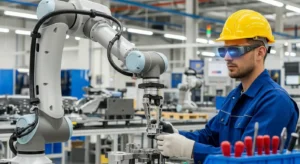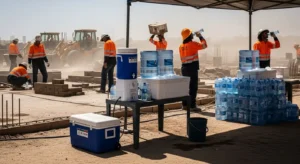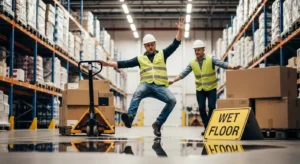Workplace Accidents in 2025: What New Risks Should You Know?
In 2025, workplace accidents are no longer simply about slips, trips and falls. Many traditional hazards persist — but a new set of risks has emerged, driven by technology, changes in work practices and evolving regulatory landscapes. Whether you’re an employee, employer or legal advisor, understanding these shifts is essential for prevention, claim planning and ensuring safety compliance.
Introduction: A Changed Risk Landscape
The data show a mixed picture. On one hand, workplaces are reporting lower overall injury rates — for example, in the U.S. private‐industry employers recorded approximately 2.6 million nonfatal cases in 2023, down from 2.8 million in 2022. On the other hand, new risk factors are emerging that complicate the picture: mental-health related incidents, remote/Hybrid work hazards, AI/automation risks, climate-related exposures and employee resistance to safety protocols. According to the 2025 “State of Workplace Safety” report from Pie Insurance, 75% of small businesses experienced workplace injuries last year — half of which were deemed preventable.
As a law firm focused on accident and injury claims, we at [Your Law Firm] recognize that for injured workers or firms facing liability, knowing these evolving risks can make the difference between a successful claim (or defence) and a missed opportunity. Below, we review the key emerging risks in 2025 and what you should be doing about them.
1. Technology & Automation: Benefits and New Hazards
The integration of technologies such as wearables, AI-driven safety systems, robotics and automation has been widely hailed as a step forward in workplace safety — and it is. But it also brings new forms of risk.

- Wearable tech & monitoring systems: Employers are deploying smart helmets, smart watches, exoskeletons and real-time monitoring systems to detect fatigue, hazardous movement or environmental hazards. According to a recent white paper, these tools are expected to become increasingly common in 2025.
- Robotics and automation risk: With machines increasingly interacting with human workers (so-called cobots), risks such as unexpected machine behaviour, human-robot collisions or maintenance errors become real. In such cases, fault lines may blur between worker error, machine malfunction and design defects.
- Data, AI and predictive systems: Organizations are using analytics to predict accident likelihood — but AI models are only as good as the data and assumptions behind them. Inaccurate predictions may lead to complacency rather than prevention.
From a legal perspective, these technologies create important issues: Are wearable-monitoring systems properly calibrated and regulated? Is a worker’s refusal or failure to wear such tech a contributory risk? When automation fails, who is liable — the manufacturer, the operator or the employer?
2. Remote, Hybrid & Non-Traditional Work Environments
The trends in workplace location and structure have changed dramatically since the COVID-19 era. Many companies now have a mix of on-site, remote and hybrid workers; these new models bring distinctive safety issues.
Some of the emerging risks include:
- Ergonomic and musculoskeletal injuries: Remote workers may not have ideal workstation setups at home, increasing risk of neck/back strain or repetitive stress injuries.
- Home-based environment hazards: A home workspace may not be built for industrial-level safety standards (lighting, ventilation, trip hazards, inadequate emergency evacuation).
- Reduced oversight & supervision: When employees are dispersed, maintaining consistent safety culture, training, monitoring and timely hazard correction becomes harder.
- Blurred boundaries and fatigue: Remote workers often work longer hours, have less clear breaks and may be more prone to fatigue-related errors or accidents.
For claimants, this means if an injury occurs in a non-traditional setting (remote site, home office, shared workspace), the question of employer responsibility or premises liability may be more complex. It’s critical to investigate whether the employer provided appropriate training, equipment, and monitoring — or if the hazard originated outside the employer’s control.

3. Mental Health, Stress & Safety Culture
In 2025, we’re seeing increasing recognition that mental health is a safety issue — not just a wellness issue. According to the 2025 Pie report, mental-health related incidents surpassed physical slips/trips/falls as a leading risk for small businesses, with 46% identifying mental health as their greatest safety concern.
Stressed, anxious or fatigued employees are more likely to make errors, take shortcuts or fail to recognise hazards. Some of the key dimensions:
- Workplace violence and aggression: Incidents of aggression, harassment and violence (from colleagues, customers or the public) are rising and now factor into overall safety risk.
- Cognitive overload and distractions: Hybrid/remote work, constant notifications and blurred roles can reduce focus and situational awareness — increasing risk of accidents, especially in industrial or high-hazard settings.
- Psychological injury claims: Injuries aren’t always physical. Psychological trauma, stress-related disorders, PTSD from workplace incidents (e.g., a near-miss, an assault) are now crossing into the compensation/claims sphere.
For legal practitioners and claimants, it’s crucial to document not just the physical injury but the mental and emotional elements — symptoms, treatment, how the work environment contributed, and whether adequate employer controls (training, counselling, hazard recognition) were in place.
4. Environmental and Climate-Related Hazards
Climate change is no longer a distant concern when it comes to workplace safety — it is here. Workers in many industries are facing new and more frequent exposures to heat stress, extreme weather, wildfires, flooding, and other environmental hazards.
For example, a 2025 report highlighted that more than 2.4 billion workers globally are exposed to heat stress, with significant productivity drops and increased injury risk with each degree of rise above safe thresholds.
Key hazard areas include:
- Outdoor workers: Construction, agriculture, delivery/logistics are heavily impacted by temperature extremes, storms and wildfire smoke.
- Indoor workers in poor environments: Without proper HVAC or climate controls, heat, humidity or pollution exposures may rise.
- Changing regulatory landscape: New legislation is emerging to hold employers accountable for climate-related exposures and to adopt adaptation strategies.
In terms of liability and claims: if a worker suffers injury due to heat exhaustion, wildfire smoke inhalation or extreme weather-related hazard — the key will be whether the employer assessed and managed the risk, provided rest breaks, proper PPE/ventilation, and had emergency plans in place.
5. Regulatory & Compliance Shifts
2025 is seeing notable changes in regulation and enforcement activity around workplace safety. For example, new or upcoming laws in certain jurisdictions are imposing stricter penalties for repeated safety failures.
Important regulatory trends include:
- Greater fines and corporate liability: Some governments are moving toward fining companies up to a set percentage of profit for repeated fatal accidents.
- Enhanced reporting and transparency: More jurisdictions require detailed incident data, near-miss reporting, contractor/subcontractor accountability and supply-chain oversight.
- Focus on high-hazard industries and gig economy: Industries such as construction, manufacturing, logistics and platforms that employ gig workers are under increased scrutiny.
- Integration of safety and ESG (environmental, social, governance): Corporations are increasingly treating safety as part of their ESG commitments — meaning safety failures can impact investor and reputational risk as much as direct injury risk.
From a claim perspective, this means that the defence side may highlight compliance, training logs and protocols; claimants will need to show whether those systems were sufficiently tailored and executed.
6. Workforce Demographics, Skills & Training Gaps
The workforce is changing — older workers, more diverse teams, more contract/temporary/gig labour, and skill shortages in many sectors. These demographic shifts bring new safety challenges.
Some of the key issues:
- Generational risk differences: Older workers may have slower reflexes or pre-existing conditions; younger workers may lack experience and may be more exposed to gig/contract work with less training.
- Skill shortages and turnover: Reports show that inadequate training or informal “shadowing” is still used in many workplaces rather than formal safety education.
- Contract/temporary/outsourced workforce: These workers may receive less induction, supervision or employer investment in safety culture — increasing vulnerability to accidents.
This means in a claim scenario, the question of whether a worker received appropriate training (and refresher training) is more important than ever. Employers should also demonstrate that their training programmes keep up with changing risk profiles.
7. Data & Analytics: From Incident Reporting to Predictive Prevention
As organisations collect more safety-data, incident logs, near-miss reports and wearable sensor outputs, they are shifting from just reacting to accidents to trying to predict and prevent them.
Key trends:
- Near-miss reporting and leading indicators: More companies are focusing on near-misses (events that didn’t cause injury) as early warning signs rather than only waiting for actual injuries.
- Predictive and prescriptive analytics: Using AI/ML to flag tasks, times of day, worker fatigue or environmental conditions as higher risk.
- Data transparency and benchmarking: Employers are comparing safety metrics across sites, industries and suppliers, creating accountability and earlier intervention.
However, from a legal standpoint: the presence of data doesn’t automatically absolve liability. If a company collects data but fails to act on known hazards flagged by analytics, that may count against them. Conversely, claimants may need access to data to show system failures or ignored warnings.
8. Residual Traditional Hazards — But Evolving
Even in 2025, many “classic” causes of workplace accidents remain prominent: slips/trips/falls, equipment entanglement, vehicle incidents, manual handling injuries. The difference is that the context is shifting.
For example:
- Slips/trips/falls: While preventable and well-understood, these still lead to many workplace claims. According to recent statistics, falls remain a major cause of fatalities in construction.
- Vehicle incidents: With delivery/logistics growth, commercial vehicle accidents are increasingly part of workplace‐injury risk. The Pie Insurance report noted that 42% of small businesses with vehicles reported incidents last year.
- Manual handling/musculoskeletal disorders: These remain high in sectors such as manufacturing, warehousing and healthcare.
The takeaway: traditional hazards have not vanished. What has changed is how they interact with new work-models, technologies and hybrid environments — meaning they may present differently and require updated risk assessments.
9. What This Means for Employees, Employers & Claims
Given all the shifts outlined above, here’s what each stakeholder should focus on:
For Employees
- Understand that safety is no longer just physical-hazard awareness; it includes mental-health, remote settings, automation and data monitoring.
- If you’re injured or believe you may be, keep thorough records: where you were working, what kind of environment, what you were asked to do, whether you had appropriate training and equipment, and whether any technology (wearable, AI monitoring, automation) was involved.
- Ask questions about employer safety policies in remote/hybrid settings, any wearable/monitoring requirement, your rights around mental health impacts, and whether relevant safety data is being collected.
For Employers
- Update risk assessments to include hybrid/remote work, climate exposures, mental health/fatigue, automation interaction and data monitoring systems.
- Ensure training is continuous, inclusive of new technologies and hazards, and that contract/temporary staff receive equal induction and supervision.
- Make sure data collected from sensors/analytics is actioned promptly; a monitoring system that flags hazards but does nothing may increase liability.
- Promote a safety culture — not just compliance. As the Pie report emphasised: safety isn’t just a checkbox — it’s a competitive advantage.
For Claimants and Legal Advisors
- When investigating a workplace accident from 2025, don’t assume only “physical hazard” issues — check for wearable tech usage, automation interactions, remote environment, mental health contributions, data logs, AI monitoring involvement.
- Access employer safety data, incident/near-miss logs, training records (especially relevant for modern hazards), remote-work policies, wearable monitoring policies and climate/heat-risk mitigation plans.
- Be prepared for defence arguments around “we had sensors/AI so we did our part” — the key will be whether data was acted upon, whether training was adequate for new hazards, and whether novel exposures were assessed.

10. Practical Steps & Preventive Measures
Here are actionable steps for organisations and individuals to stay ahead in 2025:
- Conduct a fresh risk assessment: Include hybrid/remote work environments, wearable tech/automation interaction, climate exposures and mental-health impacts.
- Update training: Include modules on fatigue, remote work hazards, sensor/wearable tech, automation interface, climate risk (heat, storms), and mental-health awareness.
- Implement near-miss reporting and analytics: Encourage reporting of near-misses, use data to spot patterns (time of day, task, tech interface) and intervene early.
- Monitor and act on wearables/automation feedback: If sensor or wearable tech flags fatigue, hazard or unsafe posture – ensure follow-up action, not just monitoring.
- Address mental health and safety culture: Provide resources, encourage rest breaks, evaluate workload, reduce fatigue, include remote workers in wellbeing programmes.
- Create climate-resilience safety plans: For outdoor workers or poorly ventilated indoor sites: include heat-stress monitoring, rest zones, contingency for extreme weather, smoke/humidity mitigation.
Conclusion
Workplace accidents in 2025 are shaped by both the familiar and the new. Traditional hazards remain, but the addition of remote work, automation, wearable tech, mental-health risk, climate exposures and shifting regulations mean that the landscape has changed significantly.
For employees, employers and legal professionals alike, staying ahead means broadening the focus of safety beyond the “hard hat and high-vis” era. It means recognising that data, technology, environment and psychology all play a role.
If you or a loved one has been injured at work — whether onsite, remotely or in a hybrid model — it’s vital to engage legal advice that understands these modern dynamics. At [Your Law Firm], we help clients navigate the full spectrum of workplace accident claims, including the new and emerging risk factors of 2025.
For more in-depth industry insights, see the detailed article from the American Society of Safety Professionals: Top Trends in OSH for 2025.

